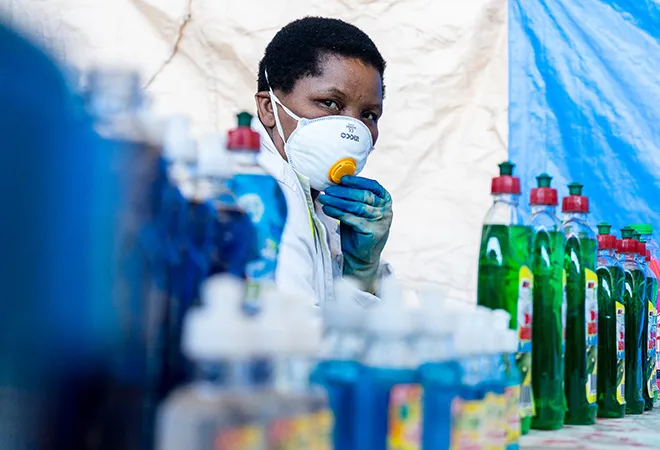-
CENTRES
Progammes & Centres
Location
Caribbean countries are already facing the existential threat of anthropogenic climate change — the timing of the pandemic could not attack the region at a more inopportune period of its history.

COVID-19 — a global pandemic, is undoubtedly a worse crisis humans have ever experienced ever since the 1930s. This pandemic is known as having no economic, demographic, political or social boundaries as it strikes wherever conditions are conducive to its deadly transmission. Unfortunately, there seems to be a correlation between poverty conditions and the spread of COVID-19 in many parts of the world, including the Caribbean.
At least 32 countries have already been affected in the Caribbean, placing the associated socio-economic consequences at high risk. The below table displays data of the COVID-19 from a sample of various countries in the Caribbean, highlighting the impact(s) of the virus in these countries with the help of confirmed cases and deaths.
| Selected Countries | Total Population | No. of Confirmed Cases 8 April 2020 | No. of Cases 12 June 2020 | No. of Deaths 8 April 2020 | No. of Deaths 12 June 2020 |
| Anguilla | 14,996 | 3 | 3 | 0 | 0 |
| Antigua and Barbuda | 97,886 | 19 | 26 | 1 | 3 |
| Bahamas | 393,041 | 40 | 103 | 7 | 11 |
| Barbados | 287,358 | 13 | 96 | 3 | 7 |
| Belize | 397,206 | 8 | 20 | 0 | 2 |
| British Virgin Islands | 30,220 | 3 | 8 | 0 | 1 |
| Cuba | 11,326,953 | 515 | 2,233 | 15 | 84 |
| Cayman Islands | 65,679 | 37 | 186 | 1 | 1 |
| Grenada | 112,496 | 12 | 23 | 0 | 0 |
| Guyana | 786,357 | 37 | 158 | 6 | 12 |
| Haiti | 11,394, 839 | 27 | 3,941 | 1 | 64 |
| Jamaica | 2,960, 505 | 63 | 611 | 4 | 10 |
| Martinique | 375, 279 | 154 | 202 | 6 | 14 |
| Monserrat | 4,992 | 8 | 11 | 0 | 1 |
| Saint Lucia | 183, 584 | 14 | 19 | 0 | 0 |
| Saint Kitts and Nevis | 53, 179 | 11 | 15 | 0 | 0 |
| Suriname | 586, 350 | 10 | 187 | 1 | 4 |
| Trinidad and Tobago | 1,399,258 | 109 | 117 | 8 | 8 |
| Turks and Caicos | 38,688 | 8 | 12 | 1 | 1 |
| Table showing number of confirmed positive COVID-19 cases and number of deaths by country between 8 April and 12 June 2020. | |||||
| Data source: Worldometers, Caribbean Disaster Emergency Management Agency |
Simple (statistical) analysis of the data has revealed several issues.
i. The countries identified in the table have different population sizes. It can be observed that the number of positive cases are higher in countries with a larger population — as indicated by Cuba, Haiti and Jamaica. Similarly, Monserrat, Anguilla and the British Virgin Islands that have the lowest confirmed cases are also scarcely populated. While there are likely to be other factors that also contribute to the data above, the population size is directly related to the number of cases in countries.
ii. There are outliers; for example, with a population of 65, 679, the Cayman Islands has 186 confirmed cases. This figure represents the fifth highest of the country sample data displayed for confirmed cases while the total population puts it as the sixth. Based on the population, the confirmed cases for the Cayman Islands should have been much lower, thus making this one of the easily identified outliers of the data.
iii. The percentage of confirmed cases for all identified countries in relation to total population is below 1% (exactly 0.02%). This figure remains relatively constant for most countries identified, with the highest percentage figure of 0.3, which is still significantly below 1% of any country’s population having confirmed cases.
iv. Correlation between the number of deaths and population or confirmed cases cannot be derived easily. This number fluctuates greatly as countries with fewer cases have high number of deaths and the visa versa.. To this end, the number of deaths have little to do with confirmed cases. However, the table does identify two countries with the largest population and confirmed cases also have the largest number of deaths. Cuba and Haiti have similar populations of above 11 million people, with 2,233 and 3,941 confirmed cases respectively. Although Haiti has the highest number of confirmed cases of all countries within the sample pool, it doesn’t have the highest number of deaths. The highest number of confirmed deaths is in Cuba (84) followed by Haiti (64). One possible reason to this could be, mitigating life saving measures were taken immediately. Guyana and Suriname, have a similar population as well as number of confirmed cases. Suriname with the higher number of confirmed cases (187) had a lower number of deaths than Guyana (158). While 4 people died of COVID-19 in Suriname, 12 died in Guyana.
v. General trends suggest that as confirmed cases increase, the number of deaths will similarly increase. What has been observed is countries with the highest number of confirmed cases also have the highest number of deaths. Thus, it can be expected that as confirmed cases increase so too will the number of deaths increase.
vi. It is interesting to see the rise in the number of cases over time. During the three-month period there was a sharp increase in confirmed cases is many countries among the data sample and an overall increase in confirmed cases in all but one country in the data sample. An exponential increase was seen in few countries, for example, Haiti went from 27 cases in April to 3,941 in June. This suggests that the increase in the number of cases will continue unless mitigation measures are taken and an attitude change occurs individually to protect ourselves and others.
vii. Some countries have been able to contain the spread the virus within their territories. Anguilla is the best example wherein after recording three cases in April, there were no further increases. Similarly, other countries after recording a few cases in the initial phase were able to contain the further spread. Countries like Saint Kitts and Nevis, Grenada, St. Lucia and Anguilla recorded no fatalities. The steps taken by these countries to garner these results may be prudent to try to ascertain what was done, what worked well and what can be learnt and integrated in other countries that are not doing as well.
Several contributing factors to the transmission and spread of COVID-19 can be posited. Firstly, spread through migration processes (emigration and immigration). Secondly, the nonchalant attitudes of the citizens and their refusal to adhere to precautionary principles. Thirdly, the lack of the adequate facilities to conduct random tests, with the view to eliminating the spread at specific locations as well as limited human, financial, material, and physical resources to contain the spread through clusters. Fourthly, poor health etiquette such as failing to wash hands thoroughly (may be due to the absence of social infrastructure such as potable water supply), not wearing a face masks (due to civil resistance, lack of financial capital to purchase same, or inadequate supply available to the public). Lastly, lack of awareness and knowledge of the virus has led to the complacency.
Mitigation measures taken to date have been varied and include social distancing in public places, at work, curfews, closure of educational institutions and businesses with the exception of pharmacies and supermarkets, reduced banking hours. Most government agencies and international offices such as embassies have enacted policies that either permit their employees to work from their homes, or to operate on a rotational basis. The cumulative effect has led to other issues such as decreased productivity, loss of revenue (particularly associated with the tourism and hospitality industry), loss or reduction of livelihoods and household incomes, increased poverty, increased psychological suffering of families, and loss of human capital that is central to a country’s socio-economic development.
Several measures have been implemented with some degree of success, these include the following:
• Regulation such as the Bahamas Emergency Powers (COVID-19), or the Public Health Ordinance Regulations covering COVID-19 in Trinidad and Tobago. Such regulations grant the Ministers of Health the power to impose restrictions on their citizens. Ignoring these restrictions may result in substantial fines and/or several months of imprisonment.
• Testing and subsequent isolation/quarantine.
• Contact tracing to minimise risk of transmission.
• Travel ban/restrictions.
• Social distancing.
• Curfews: In some countries these are observed for 24 hours; in other parts — from 6 p.m. to 6 a.m.
• Public awareness and education campaigns via the radio, television and social media such as coronavirus Facebook page.
• Hotlines for members of the population to seek clarifications, report cases, etc.
Caribbean countries are already facing the existential threat of anthropogenic climate change, therefore the timing of the pandemic could not ‘attack’ the region at a more inopportune period of its history. The sustainable development gains can be undermined, given the current pressure for countries to divert their financial capital to develop the necessary infrastructure and technology to help guarantee the survival of their human capital. Unarguably, COVID-19 provides an opportunity to governments to revisit their level of emergency preparedness. To this end, there is need for the Caribbean community to design a holistic and forward-looking strategy to help member countries to recover and to increase their resilience to any future pandemic. Data gathering and analysis, using tools such as geographic information systems (GIS) and participatory appraisals must become a norm to ensure evidence-based policy making. If such initiatives are carefully explored and implemented, there is a chance for a brighter future for the Caribbean. The time to act is therefore NOW.
The views expressed above belong to the author(s). ORF research and analyses now available on Telegram! Click here to access our curated content — blogs, longforms and interviews.

Paulette Bynoe is a Senior Lecturer and the former Dean of the Faculty of Earth and Environmental Sciences at the University of Guyana. Paulette has ...
Read More +